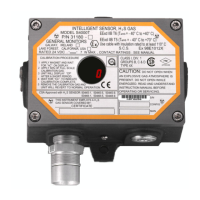Model S4000T
Quick Start Guide
iv
1.0 Quick Start Guide
1.1 Product Location
WARNING - Installation and Maintenance must be carried out by suitably skilled and
competent personnel only.
WARNING - The Model S4000T Intelligent Sensor contains components which can
be damaged by static electricity. Special care must be taken when wiring the system
to ensure that only the connection points are touched.
There are no standard rules for sensor placement since the optimum sensor location
is different for each application. The customer must evaluate conditions at the facility
to make this determination. Generally, the Model S4000T Intelligent Sensor should
be easily accessible for calibration checks.
• The transmitter should be mounted with the sensor pointing down to prevent water
build-up on the sensor head.
• The transmitter should not be placed where it may be coated by contaminating
substances.
• Although the Model S4000T is RFI resistant, it should not be mounted in close
proximity to radio transmitters or similar equipment.
• Locate the Model S4000T where prevailing air currents contain the maximum
concentration of gas.
• Locate the Model S4000T near possible sources of gas leaks.
• Observe the Model S4000T’s temperature specification and locate the unit away
from concentrated sources of heat.
• Transmitters should be mounted in an area that is as free from wind, dust, water,
shock, and vibration as possible. See Section 9.2.4 for the environmental
specifications of the unit. If the sensor can not be located away from dust and rain,
we recommend the use of our splash guard (GM P/N 10395-1) to help protect the
sensor.
1.1.1 Sensor Poisons and Contaminants
Sensors may be adversely affected by prolonged exposure to certain materials. Loss
of sensitivity or corrosion may be gradual if such materials are present in low
concentrations, or it may be rapid at high concentrations. The more important
materials adversely affecting sensors are:
• Silicones (often contained in greases and aerosols)
• Halides: compounds containing Fluorine, Chlorine, Bromine and Iodine
• Heavy metals, e.g. Tetraethyl Lead
• Caustic and Acidic liquids and vapors
• Glycol
The presence of contaminants in an area does not necessarily preclude the use of a
Model S4000T Intelligent Sensor. The feasibility of using a sensor in such areas must
be determined by an analysis of the specific factors in each application, and General
Monitors should be consulted before attempting any such installation.

